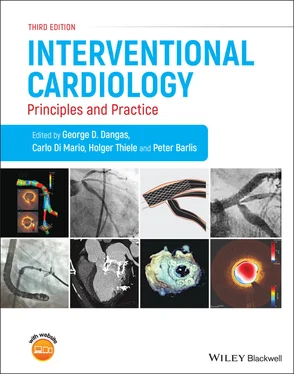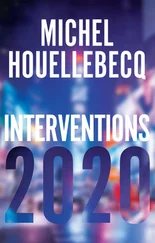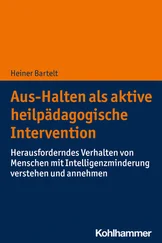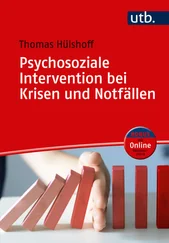Interventional Cardiology
Здесь есть возможность читать онлайн «Interventional Cardiology» — ознакомительный отрывок электронной книги совершенно бесплатно, а после прочтения отрывка купить полную версию. В некоторых случаях можно слушать аудио, скачать через торрент в формате fb2 и присутствует краткое содержание. Жанр: unrecognised, на английском языке. Описание произведения, (предисловие) а так же отзывы посетителей доступны на портале библиотеки ЛибКат.
- Название:Interventional Cardiology
- Автор:
- Жанр:
- Год:неизвестен
- ISBN:нет данных
- Рейтинг книги:4 / 5. Голосов: 1
-
Избранное:Добавить в избранное
- Отзывы:
-
Ваша оценка:
- 80
- 1
- 2
- 3
- 4
- 5
Interventional Cardiology: краткое содержание, описание и аннотация
Предлагаем к чтению аннотацию, описание, краткое содержание или предисловие (зависит от того, что написал сам автор книги «Interventional Cardiology»). Если вы не нашли необходимую информацию о книге — напишите в комментариях, мы постараемся отыскать её.
Interventional Cardiology
Interventional Cardiology
Interventional Cardiology — читать онлайн ознакомительный отрывок
Ниже представлен текст книги, разбитый по страницам. Система сохранения места последней прочитанной страницы, позволяет с удобством читать онлайн бесплатно книгу «Interventional Cardiology», без необходимости каждый раз заново искать на чём Вы остановились. Поставьте закладку, и сможете в любой момент перейти на страницу, на которой закончили чтение.
Интервал:
Закладка:
Table of Contents
1 Cover
2 Title Page
3 Copyright Page
4 Contributors
5 Foreword
6 Preface
7 Acknowledgments
8 About the Companion Website
9 PART I: Principles and Techniques SECTION I: Basic Knowledge CHAPTER 1: Atherogenesis and Inflammation Pathogenesis of atherosclerosis Progression of atherosclerotic plaque The vulnerable plaque Macrophage infiltration Cholesterol crystal (CCs) Neovascularization Neoatherosclerosis Near infrared spectroscopy (NIRS) Lipid rich plaques Serum markers correlated to plaque inflammation Markers of inflammation Biomechanical stress as a trigger for plaque progression and rupture Future challenges in the treatment of vulnerable plaques ConclusionsReferences CHAPTER 2: The Essentials of Femoral Vascular Access and Closure Femoral access Ultrasound guided femoral access Femoral access closure ConclusionsReferences CHAPTER 3: Radial Artery, Alternative Arm Access, and Related Techniques Introduction Rationale and evidence for transradial access Pre‐procedural considerations Access technique and navigating common problems Complications and management Future directions ConclusionsReferences CHAPTER 4: Optimal Angiographic Views for Coronary Angioplasty Catheter selection Coronary intubation Diagnostic angiography Lesion‐specific approach Ventriculography Transplanted HeartReferences CHAPTER 5: Material Selection Guide catheter selection Support Guidewire selection Balloon catheters Microcatheters ConclusionsReferences CHAPTER 6: Statistical Essentials in the Design and Analysis of Clinical Trials The fundamentals Trial design: the fundamentals Additional topics in clinical design and analysis ConclusionsReferences SECTION II: Imaging and Physiology CHAPTER 7: Physiologic Assessment and Guidance in the Cardiac Catheterization Laboratory Why to use physiology Practical considerations of pressure wire measurement Hyperemic agents Pressure wire assessment after PCI Catheter laboratory conditions for pressure wire assessment Performing an optimal pressure wire pullback Practical tips and tricks of performing the iFR Pullback Co‐Registration of iFR‐Pullback with Angiographic Data Commonly missed mistakes in Physiological Assessment Pressure‐only indices to guide coronary intervention The instantaneous wave‐free ratio (iFR) and other non‐hyperemic pressure ratios (NHPRs) Choosing between NHPR and FFR: when is one better than the other? Physiology after PCI Using Physiology to Guide PCI Strategy The MicrocirculationReferences CHAPTER 8: Intravascular Ultrasound Principles of IVUS imaging Equipment for IVUS examination Imaging artifacts Image acquisition and presentation Normal artery morphology Quantitative analysis Qualitative analysis Comparison of IVUS and angiography Guidance for stent implantation ConclusionsReferences CHAPTER 9: Optical Coherence Tomography, Near‐Infrared Spectroscopy, and Near‐Infrared Fluorescence Molecular Imaging Optical coherence tomography Catheter preparation, calibration, image acquisition and fluoroscopic co‐localization Normal coronary vessel anatomy Guidance of percutaneous coronary intervention Near‐infrared spectroscopy Near‐infrared fluorescence molecular imagingReferences CHAPTER 10: Multislice Computed Tomography (MSCT) and Cardiovascular Magnetic Resonance (CMR) Imaging for Coronary and Structural Heart Disease Coronary MSCT angiography—technique Trials and current guidelines Cardiovascular magnetic resonance ConclusionsReferences SECTION III: Revascularization in Different Clinical Settings CHAPTER 11: Stable Coronary Artery Disease Guidelines on the management of stable angina Indications for coronary angiography Percutaneous coronary intervention for stable angina Comparison of percutaneous and surgical revascularization Recommendations for revascularization in stable angina ConclusionsReferences CHAPTER 12: PCI Strategies in Acute Coronary Syndromes without ST Segment Elevation (NSTE‐ACS) Emergency department diagnosis and risk stratification Early invasive versus ischemia‐guided strategy Revascularization for NSTE‐ACS Adjunctive pharmacologic treatment ConclusionsReferences CHAPTER 13: Primary and Rescue PCI in STEMI Introduction Timing of intervention in STEMI Procedure technique Pharmacological management ConclusionReferences CHAPTER 14: The Management of Cardiogenic Shock and Hemodynamic Support Devices and Techniques Introduction Definition of Shock Epidemiology Management of cardiogenic shock ConclusionsReferences SECTION IV: PCI in Different Lesion Types CHAPTER 15: PCI for Unprotected Left Main Disease: Current Evidences and Plenty of Questions Introduction PCI for unprotected left main disease in practice: beyond the rule “as simple as possible” Take home messagesReferences CHAPTER 16: Bifurcation Lesion Stenting Coronary bifurcation anatomy and function Classification of bifurcation stenting techniques Stepwise provisional side branch stenting strategy Two‐stent techniques Left main stenting Final remarksReferences CHAPTER 17: Risk Stratification Approach to Multivessel Coronary Artery Disease Introduction Risk scores in MVCD Surgical risk scores Complex PCI Role of medical therapy ConclusionReferences CHAPTER 18: Chronic Total Coronary Occlusion Introduction Morphology of the occlusion Indication for treatment Basic rules of engagement Guide wire selection and handling Advanced antegrade recanalization techniques Antegrade dissection and reentry Retrograde approach Algortihmic approach for intervention of chronic total occlusions Balloon dilatation Stent placement Intravascular ultrasound in CTOs When to stop a procedure ComplicationsReferences CHAPTER 19: Percutaneous Coronary Intervention of Arterial and Vein Grafts Introduction Scope of the problem Secondary revascularization after CABG surgery: PCI or repeat surgery? PCI for acute post‐operative graft failure PCI in degenerated saphenous vein grafts ConclusionsReferences CHAPTER 20: Interventional Approach in Small Vessel, Diffuse, and Tortuous Coronary Artery Disease Introduction Small vessel disease Diffuse vessel disease Tortuous vessel diseaseReferences CHAPTER 21: In‐Stent Restenosis in the New Generation DES Era Definition Incidence Clinical presentation Pathophysiologic mechanisms Morphologic pattern of DES restenosis Predictors of DES restenosis Role of coronary imaging Approach to DES restenosisReferences CHAPTER 22: High Risk Percutaneous Coronary Intervention Introduction Defining high‐risk PCI Pathophysiological rationale for mechanical support in HR‐PCI An integrated approach to high‐risk PCI ConclusionReferences SECTION V: Special Techniques and Complications CHAPTER 23: Laser, Rotational, Orbital Coronary Atherectomy, and Coronary Intravascular Lithoplasty Background Rotational atherectomy Excimer laser coronary atherectomy Orbital atherectomy Coronary intravascular lithoplasty ConclusionsReferences CHAPTER 24: Thrombus‐containing Lesions Introduction How to deal with thrombus‐containing lesions ConclusionsReferences CHAPTER 25: Specialized Balloons in Percutaneous Coronary Intervention Introduction Cutting and scoring balloons Coronary bifurcation sidebranch access Clearway catheter for intracoronary drug delivery Flash Ostial dual balloon angioplasty catheter Drug‐eluting balloons ConclusionsReferences CHAPTER 26: Coronary Artery Dissections, Perforations, and the No‐Reflow Phenomenon Introduction Coronary artery dissection Coronary artery perforation Classification Devices and materials for CAP The no‐reflow phenomenon Management of distal embolization. Intracoronary infusions ConclusionsReferences CHAPTER 27: Vascular Access Site Complications Introduction Common femoral artery related complications Femoral artery access techniques to prevent vascular complications Vascular closure devices for femoral access Vascular closure devices in procedures using
Читать дальшеИнтервал:
Закладка:
Похожие книги на «Interventional Cardiology»
Представляем Вашему вниманию похожие книги на «Interventional Cardiology» списком для выбора. Мы отобрали схожую по названию и смыслу литературу в надежде предоставить читателям больше вариантов отыскать новые, интересные, ещё непрочитанные произведения.
Обсуждение, отзывы о книге «Interventional Cardiology» и просто собственные мнения читателей. Оставьте ваши комментарии, напишите, что Вы думаете о произведении, его смысле или главных героях. Укажите что конкретно понравилось, а что нет, и почему Вы так считаете.










